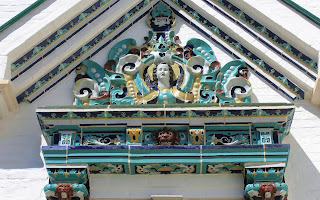 Founded under Patriarch Nikon in the 17th century in Istra on the outskirts of Moscow, the New Jerusalem Monastery was meant to evoke the Holy Land and serve as a pilgrimage site. Two buildings, the Church of the Tomb of the Holy Savior and the Cathedral of the Resurrection, form the nucleus of the monastery. Inside the two churches, the icon, decoration, and inscriptions represent the most important group of polychrome ceramic work ever produced in Russia. Built between 1658 and 1698, New Jerusalem is an extraordinary example of Russian ecclesiastical architecture. By the mid-18th century, the dome of the Cathedral of the Resurrection had failed and it was restored in the Baroque style in 1748. In the early 19th century, a neoclassical side chapel of Mary Magdalene was added. Bombing by Nazi occupying forces in 1941 destroyed the great dome of the Cathedral of the Resurrection; it was partially reconstructed in the 1980s. Sporadic restoration and maintenance followed, but came to a halt in the 1990s.
Founded under Patriarch Nikon in the 17th century in Istra on the outskirts of Moscow, the New Jerusalem Monastery was meant to evoke the Holy Land and serve as a pilgrimage site. Two buildings, the Church of the Tomb of the Holy Savior and the Cathedral of the Resurrection, form the nucleus of the monastery. Inside the two churches, the icon, decoration, and inscriptions represent the most important group of polychrome ceramic work ever produced in Russia. Built between 1658 and 1698, New Jerusalem is an extraordinary example of Russian ecclesiastical architecture. By the mid-18th century, the dome of the Cathedral of the Resurrection had failed and it was restored in the Baroque style in 1748. In the early 19th century, a neoclassical side chapel of Mary Magdalene was added. Bombing by Nazi occupying forces in 1941 destroyed the great dome of the Cathedral of the Resurrection; it was partially reconstructed in the 1980s. Sporadic restoration and maintenance followed, but came to a halt in the 1990s.In March 2009 Russian president Dmitry Medvedev signed a presidential decree on the restoration and renovation of the New Jerusalem Monastery. The federal government was instructed to subsidize the monastery restoration fund from the federal budget from 2009.
As of June 2016, there has been great restoration done in the main cathedral, with much of the interior reconstructed and readorned. The great belltower was rebuilt to old designs.

The katholikon of the Resurrection (1656–1685) is a huge rotunda patterned after the Church of the Holy Sepulchre. The wooden dome and a cluster of neighbouring chapels are of later construction. These were designed by Francesco Bartolomeo Rastrelli, Vincenzo Bernardacci, Karl Blank, Konstantin Thon, and other leading architects of the Russian Empire.
The 17th-century belltower has 7 stories rising to the height of 58 meters and features 15 bells (the largest weighing some 500 poods). Destroyed in 1941, the structure was not rebuilt until the 2010s.
Patriarch Nikon's residence (1658)
The stone wall with towers (1690–1694) was designed by Yakov Bukhvostov, a key proponent of the Naryshkin Baroque.
Church of the Holy Trinity (1686–1698), like other major buildings, is finished with majolica and stucco moulding.
The monastery is open to visitors and is actively serving again. Many thousands of visitors come each day, especially on holidays.
Show in Lonely Planet


















































Комментариев нет:
Отправить комментарий